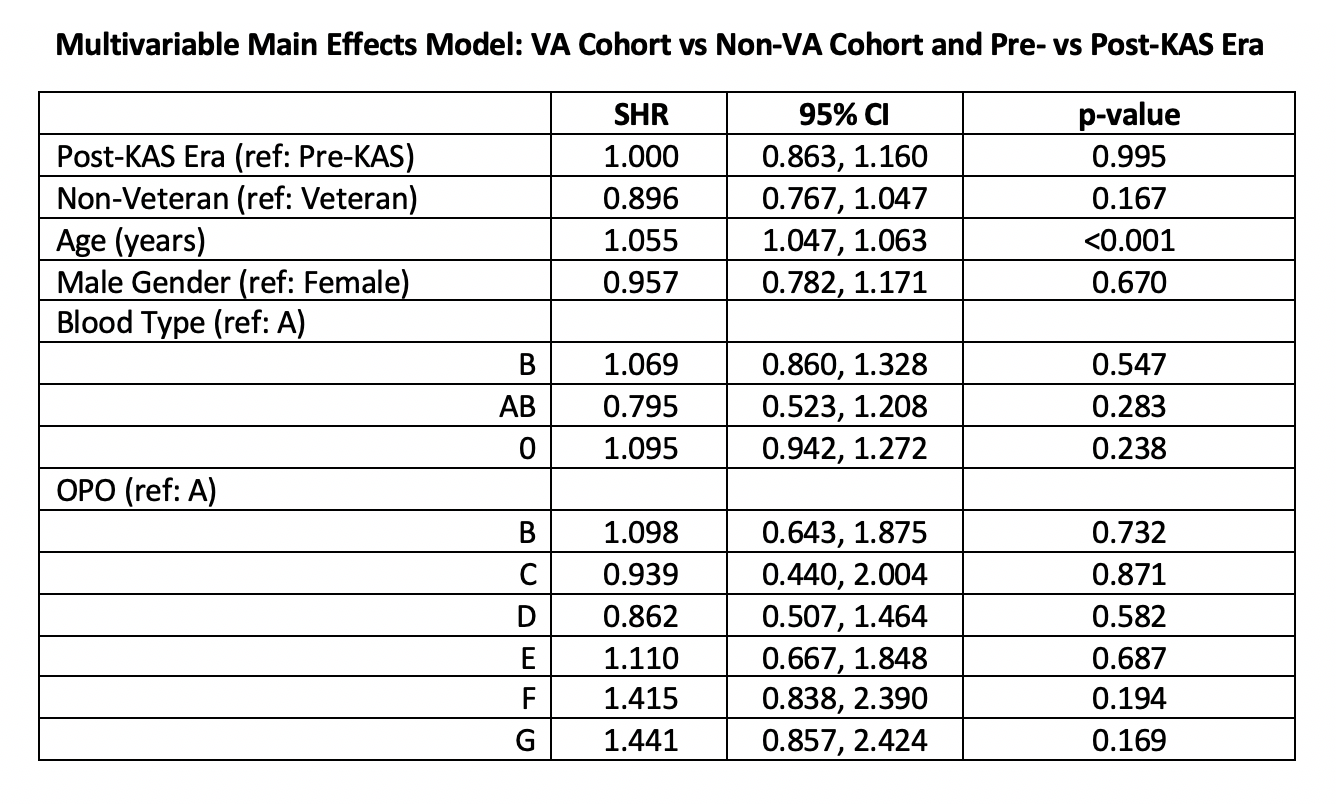Impact of Kidney Allocation System on Waiting List Outcomes for Candidates Listed in Veterans Affairs Programs
1Surgery, Vanderbilt University Medical Center (VUMC), Nashville, TN, 2Nephrology, VUMC, Nashville, TN, 3Surgery and Biostatistics, VUMC, Nashville, TN, 4Transplant Center, VUMC, Nashville, TN, 5Surgery, Division of Kidney and Pancreas Transplantation, VUMC, Nashville, TN
Meeting: 2020 American Transplant Congress
Abstract number: C-013
Keywords: Allocation, Kidney transplantation
Session Information
Session Name: Poster Session C: Kidney Deceased Donor Allocation
Session Type: Poster Session
Date: Saturday, May 30, 2020
Session Time: 3:15pm-4:00pm
 Presentation Time: 3:30pm-4:00pm
Presentation Time: 3:30pm-4:00pm
Location: Virtual
*Purpose: Kidney Allocation System (KAS) changes in 2014 prioritized highly sensitized candidates and aimed to improve longevity matching. Given that veterans are older and less sensitized, we aimed to assess the impact of KAS on waitlist outcomes in candidates listed at Veterans Affairs (VA) compared to non-VA transplant centers.
*Methods: Data from the Scientific Registry of Transplant Recipients standard analysis files were used to identify VA candidates listed for kidney transplantation (KT) since 2010. A random cohort of non-VA candidates was created, after stratifying on Organ Procurement Organization and era (pre-KAS era 1/2010 to 12/3/2014; post-KAS era 12/4/2014 to 8/2019). Multivariable cumulative incidence competing risk regression models were used to investigate likelihood of removal from the waitlist due to death or deteriorated condition with KT as a competing event and adjusting for candidate characteristics. Pre-KAS candidates remaining on the waitlist 12/3/2014 were censored as still waiting to permit balanced follow up time by era.
*Results: 6480 candidates were included [Table 1]. The VA cohort was significantly older, less sensitized, and more likely to be male (60 vs 54 years; cPRA 9.8% vs 15.5%; 95.6% male vs 61.3% male; all p<0.001). In the pre-KAS era, VA candidates were less likely to have never been on dialysis (29.1% vs 32.9%, p<0.05). Multivariable models demonstrated no significant VA by era interaction effects (all p>=0.320). After adjusting for the effect of increased age (p<0.001), there was no difference in the likelihood of an adverse waitlist outcome between KAS eras (p=0.995) and VA and non-VA cohorts (p=0.167) [Figure 1].
*Conclusions: KAS has not adversely affected candidates listed for KT at VA transplant centers. Monitoring the effect of policy on veteran access remains important as upcoming geography and MISSION Act changes have implications for VA Transplant Centers.
| Pre-KAS Era n = 2772 |
Post-KAS Era n = 3708 |
|||||
| VA (n=1386) |
Non-VA (n=1386) |
p-value | VA (n=1854) |
Non-VA (n=1854) |
p-value | |
| Age (y) (SD) | 59.2 (9.1) | 53.5 (13.5) | <0.001 | 59.7 (9.7) | 53.8 (13.5) | <0.001 |
| Male (%) | 1335 (96.3) | 849 (61.3) | <0.001 | 1762 (95.0) | 1136 (61.3) | <0.001 |
| cPRA (%) (SD) | 10.3 (21.1) | 15.7 (29.0) | <0.001 | 9.3 (20.2) | 15.3 (28.5) | <0.001 |
| Never on dialysis (%) | 403 (29.1)a | 456 (32.9)a | <0.05 | 644 (34.7) | 661 (35.7) | >0.05 |
| Table entries are mean (SD) or frequency (%). Z-tests of column proportions (p<0.05 a vs a) | ||||||
To cite this abstract in AMA style:
Walker J, Concepion B, Birdwell K, Feurer I, Rega S, Shaffer D, Forbes R. Impact of Kidney Allocation System on Waiting List Outcomes for Candidates Listed in Veterans Affairs Programs [abstract]. Am J Transplant. 2020; 20 (suppl 3). https://atcmeetingabstracts.com/abstract/impact-of-kidney-allocation-system-on-waiting-list-outcomes-for-candidates-listed-in-veterans-affairs-programs/. Accessed January 5, 2026.« Back to 2020 American Transplant Congress

